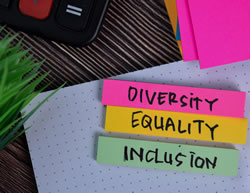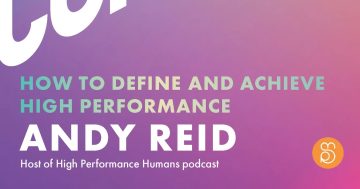Rachel Parnes* discusses how to practice diversity, equity and inclusion in the workplace.
 We’ve all had those moments where we’ve said the wrong thing, hurt someone’s feelings, or caused offense unintentionally.
We’ve all had those moments where we’ve said the wrong thing, hurt someone’s feelings, or caused offense unintentionally.
It’s not a good feeling.
And when it happens at work, the consequences can be serious.
Diversity, equity and inclusion (DEI) is not a new concept by any means — in the workplace or otherwise — but it’s an increasingly important call for all of us to heed.
To be a good employee, co-worker, and citizen in a professional world that is rapidly growing more diverse and fluid across identity traits, it’s vital to be open, understanding, and respectful toward all.
This requires a firm grasp of what DEI means, and how to apply its principles in your daily life.
Read on for definitions, resources, and more.
Defining DEI
While often grouped together, DEI is not the lump sum of one directive.
Achieving diversity, equity, and inclusion requires effort on every front, and an understanding of each distinct term.
- On the surface, diversity seems like something that can be visually identified.
But it isn’t always easy to see.
Yes, it’s a collective mixture of human beings and identities — from race, gender, and religion, to sexual orientation, age, socioeconomic status, language, and disability — co-existing in a space.
But diversity also represents everything else that makes us who we are, like our values and experiences.
Bringing different perspectives to the table is a must.
- Equity, despite common misconceptions, is not the same as equality.
Where equality is about sameness, equity is about fairness and leveling the playing field of opportunity.
No organisation can achieve equality without putting equity first.
Everyone has a role to play in creating an equitable culture.
- Inclusion is harder to define than the other two components, because it’s based on a feeling: the general sense of belonging for those throughout an organisation.
These evaluations tend to be qualitative and heavily feedback-based, but they are foundational to sustaining diversity.
In the learning course Inclusive Mindset, Inclusion Design Group CEO Dereca Blackmon explains that inclusivity is more of a mentality and guiding value than a field of practice.
She quotes Vernā Myers on this illustrative metaphor: “Diversity is being invited to the party, but inclusion is being asked to dance.”
In this scenario, the host of the party might have the most impact on the party’s guest list (just as a hiring manager or recruiter has most control over building a diverse workforce), but everyone who attends the soiree is part of making the event feel like an inclusive vibrant vibe.
Dereca takes the comparison one step further to help us understand what inclusivity really feels like.
“Inclusion is being asked to dance, but there’s more,” she says.
“At a party, a good host introduces you to new people.
“They check in on you, you know, see how things are going.
“Most importantly, they make sure you get invited to future opportunities where you’ll get to know more people at different levels in the group.
“You see, inclusion is the set of actions that people take to make sure we get the same opportunities for access and success as everyone else.”
Most of us can think of moments where we felt like a group really wanted us there with them—they valued our presence and opinion.
And we can probably recall some moments when we felt invisible or even hostile energy from people in the room.
Dereca inspires us to bring that social etiquette and understanding into the workplace.
How to embrace DEI and practice its principles
If you’ve felt an increased awareness of DEI over the past couple years, you’re not alone.
These concepts are finally making it into the mainstream as something everyone must understand, value, and continually work on.
If you’re wondering about actionable steps you can take toward a more equitable and inclusive workplace and society, here are some key focuses and helpful resources to guide you.
Overcome biases and other barriers
Understanding privilege and how it can impact different spaces, why people cover their identities, how to spot microaggressions, and other DEI barriers are critical to understand to help you make real change in your workplace.
In the course How to Be More Inclusive, Kelsey Bardfield walks through all of these topics and more.
Strive to become an ally
If you’re not a member of an underrepresented group, and want to show up as an ally, it can be tough to know where to start or how to be helpful.
As Kenji Yoshino says in the course, Becoming an Ally to All: “Too often, when we try to act as allies, we tack to one of two extremes.
We worry that we’ll make mistakes and offend someone, so we do nothing.
Or alternatively, we don’t reflect on the issues carefully enough, and we charge ahead uninformed.”
To make an impact, we have to try, and we are going to mess up.
That’s all part of it.
It can be painful for us and others, but it’s the only way to learn.
Through a series of videos, Kenji shows how to steer clear of these missteps, outlining “the empathy triangle” and highlighting examples of allyship in action.
Have open and honest conversations
The ability to have genuine conversations about sensitive topics is key in taking the step from diversity to inclusion.
Discussing Racism with Dr. Christina Greer gets to the root of why people are uncomfortable discussing race, and shares ways to break down these obstacles on a journey to understanding and connection.
In How to Speak Up Against Racism at Work, Dana Brownlee provides a helpful set of tools and techniques for healthy, productive conversations about race.
For dialogues on broader issues of DEI, our courses on Skills for Inclusive Conversations and Communicating About Culturally Sensitive Issues are strong resources.
Work on your emotional intelligence and soft skills
One reason DEI can feel hard to grasp is that it largely works with emotional impact.
It needs to be an authentic action in response to emotional and social signals.
Emotional intelligence skills can boost inclusivity by helping you better relate to and empathise with those around you.
*Rachel Parnes Senior Marketing Manager at LinkedIn
This article first appeared at linkedin.com.











